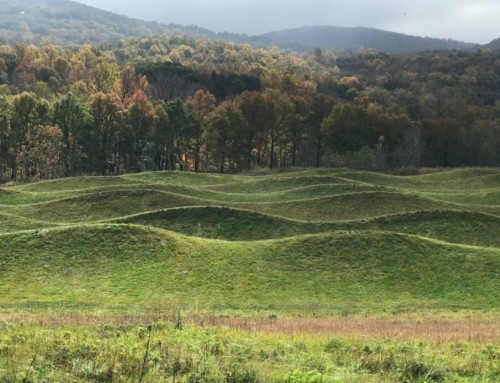I love the way everything about my sunny sideyard garden changes throughout the growing season.
So glad I replaced the lawn on that side of the house with gardens. They surround me with life, diversity and delight, experienced up close and personal.
Spring starts out short, orderly and perennial. My favorite foul weather friends – Sedum rupestre ‘Angelina’, Penstemon digitalis ‘Husker Red’ and golden feverfew – freshen up fast. Tiny bulbs and a sprinkle of self-sown hardy greens appear as soon as the snow melts.
Low brown mats of thyme and moss phlox (Phlox subulata) turn green as fleshy-grassy Allium ‘Milennium’ foliage and blades of Iris pallida ‘Aureo-Variegata’ (blue-green and pale creamy yellow stripes) poke out of the cold earth.
By early May, drifts and repeated clumps of perennials (mostly native) knit together in a pleasing, coherent composition. Intricate details and a lovely sense of flow pull me into the garden many times a day.
The sense of order persists into early June, when Monarda bradburniana, yarrow, columbines and penstemons bloom, attracting birds, butterflies and pollinators galore.
Then, almost overnight, it’s all tall wild abandon with a cast of self-sown characters.
Breadseed poppies pop up and grow three feet tall in the blink of an eye. Their fat buds split open, unfurling delicate silky cup-shaped blooms.
4-6 foot tall spikes of various verbascums (mulleins) burst into yellow bloom (photo above), along with airy Patrinia scabiosifolia and lavender anise hyssop.
It’s a voluptuous, multicolored mess – but it’s beautiful.
Until it isn’t.
Poppy foliage browns out as plants go to seed. Floppers and leaners fall over the path and crowd perennials. Slugs eat big holes in verbascum leaves.
Not a pretty picture any more.
If I made everything too neat too fast, there would be no seeds for next year’s big show, or for the birds to eat. Seeds need time to ripen, but you don’t need to let every single plant propagate itself.
Out with the ugly and overgrown. Time to pull up brown poppy stalks and shake out ripe seeds before those striped dope-fiends chipmunks eat them all. Time to cut off primary bloom stalks of the mulleins and let side-spikes take over for the next couple months.
It’s a relief to get back to a neater, shorter garden and give perennials breathing space. A second wave of self-sown nicotianas and larkspurs make an appearance once the poppy jungle has been cleared.
As autumn approaches, the perennial native meadow plants come into their own and parts of the garden get tall again, full of airy grasses, asters, long-blooming Physostegia virginiana and several Rudbeckia and Coreopsis cultivars and species.
I love the act of artful (and occasionally ruthless) tweaking, and the constant change and activity. It’s the difference between just having a garden, and gardening.





